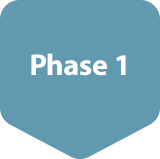Understanding
Clinical Trials
Are you or a loved one thinking
about being in a clinical trial?
This page explains what a clinical trial is. You'll learn why and how they are done. You’ll also learn about possible risks and benefits of being in a clinical trial.
What is a clinical trial?
A clinical trial is a research study. It is done to help researchers learn about medicines that are experimental. This means the medicine has not yet been approved by the U.S. Food and Drug Administration (FDA). Researchers share what they learn from the trial with the FDA. Then the FDA decides if the new medicine is approved to be used with more patients.
People volunteer to be in clinical trials to help researchers learn more. The results of these studies can help scientists find new ways to prevent, detect, diagnose, and treat disease. Being in a clinical trial helps researchers test potential treatment options. This helps them develop better medicines that can help more people.
It is important to know that there are also risks to being in a trial. Your study site doctor can help you understand these risks. However, because the medicine is experimental, the effectiveness has not been established and not all risks are known before starting the clinical trial. Furthermore, you may experience side effects from the clinical trial treatment. It is important you understand this before agreeing to be in the study.
Who conducts a clinical trial?
Clinical trials are run by a team including:
- a principal investigator, who is a medical doctor that leads the team
- a research team, which can include doctors, nurses, social workers, and other important healthcare professionals
- participants, who are the people that agree to be in the study. They help researchers learn more about the medicines being studied
How and where the team works
This team follows a “protocol.” These are the instructions for the study. The protocol includes information about:
- why the study is being done
- who will be studied
- what medicine or treatment will be used
- how long the study will last
- what tests will be done on the participants
The location of the clinical trial depends on who is running the study. It can be in different types of places, including:
- a hospital
- a clinic
- a university
- a doctor's office


Phases of a clinical trial
It takes a long time to develop a new drug – up to 10 years. There are many steps in the process. The first step includes studying and testing the drug in a laboratory. Medicines that seem to have the best chance of working safely move on to clinical trials. There are four phases of a clinical trial. Each phase has a different purpose and helps the researcher answer specific questions.
Each trial phase answers
different questions


Phase 1 usually tests the safety of a medicine or treatment. It helps researchers learn about what is a safe amount of the medicine for people to take. It also looks for any side effects or other things that can happen if you take the medicine. This phase includes 20-90 people.


Phase 2 tests to see if the medicine or treatment works in people with the condition that the medicine is meant to treat. It continues to test safety in a larger group—usually between 100-300 people.


Phase 3 makes sure the drug or treatment works. It continues to watch for side effects. It also looks at how it works compared to other treatments. This phase includes a larger group of people, usually between 1,000-3,000 participants. After Phase 3, all the information is shared with the U.S. Food and Drug Administration (FDA) and they decide if it can be approved to help other patients.


Phase 4 looks at the drug or treatment after it is approved by the FDA. Researchers continue to track the drug's safety. They also get new information on how it works and the best way to use it.
Enrolling in a clinical trial
Common reasons why people decide to be in a clinical trial include:
- to access experimental medicines that are not yet approved by the FDA
- to take an active role in their own healthcare
- to help researchers learn so they can develop better medicines that can help others
Whatever the reason, there are many things to think about before making a decision.
What to consider
before participation
Guidelines for clinical trials
Every clinical trial has guidelines. These guidelines help doctors decide who should or should not be in the study. Guidelines in trials can include:
- age
- sex
- the type or stage of a disease
- treatment history
- other medical conditions
Reasons that allow people to be in the study are called inclusion criteria. Reasons that keep people from being in the study are called exclusion criteria.
Informed consent
People interested in a clinical trial first meet with the research team. Doctors and nurses from the team explain details of the study. This process, called informed consent, helps people understand the potential risks and benefits of the study. They can then decide if they want to be in the study.
Those who want to be in the study will be asked to sign an informed consent document. This document explains:
- the purpose of the study
- how long the study will last
- how the study will run
- key contacts at the study
- risks and potential benefits
Signing this document does not mean you have to stay in the clinical trial. You can leave the study at any time.
Questions to ask
If you decide to be in a clinical trial, you will likely have questions. Some of your questions may be answered in the informed consent document. However, you should feel comfortable asking the research team any of your questions. It is important to make sure you have all your questions answered before deciding to be in a trial.
Not sure what to ask? Here are a few thought‑starters:
- Why are they doing this clinical trial?
- What kinds of tests and treatments will be involved?
- How long will the study last?
- How might this study affect my day‑to‑day life?
- Where will I have to go to be in the trial?
Possible risks & benefits
Clinical trials help researchers learn about medicines not yet approved by the FDA. Because the medicine is still being tested, the effectiveness has not been established and not all risks are known before starting the clinical trial. Furthermore, you may experience side effects from the clinical trial treatment.
Understanding what could happen
It is important to understand that possible risks could include:
- side effects which can range from unpleasant to more severe
- that the treatment does not work nor help you get better
Possible benefits of being in a clinical trial include:
- taking an active role in your own health
- getting access to an experimental treatment
- helping others
Participant safety
Safety is very important in a clinical trial. The researchers that lead the study will carefully monitor how the medicine is working. They will watch for any impacts that could be unsafe for you. Clinical research also follows safety rules set up by the FDA. These rules are built in to protect the people in the trial. Study results are shared with the FDA and medical journals as the study goes on to ensure that everyone can see the results. You should always feel comfortable talking to the study team if you do not feel safe.
For information about an Astellas clinical trial, click here.
